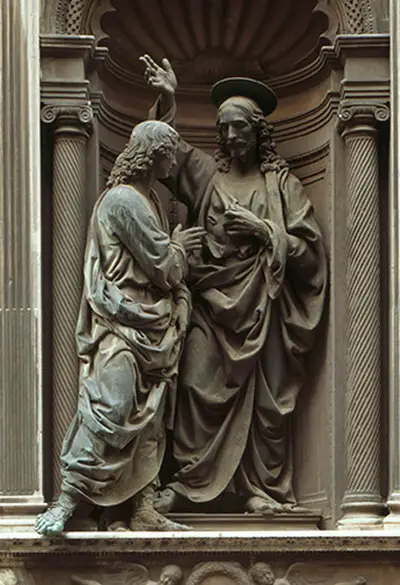Christ and St Thomas statue by Andrea Del Verrocchio is a remarkable masterpiece of intricate detailing. The instance staged by Verrocchio's figures enacts a tremendous solemnity of the events of John 20:24-29.
Viewers are introduced into a dramatic scene of Jesus and "doubting Thomas" first encounter after his resurrection. Jesus is portrayed as pulling back his robe with his left hand and the right raised to allow Thomas to touch his wound. Thomas facials express a beatific yet expectant blank state. His excitement and agitation is however not directly conveyed through his face but indirectly through the tumult of drapery that cloth him.
Thomas stands slightly below Jesus while reaching towards him. Jesus gazes down upon Thomas in a stance that conveys great disappointment but full of forgiveness. His empathy is mostly expressed through his hands. The right gracefully positioned above Thomas' head as if drawing him closer while the left draped in veils. Verrocchio's artistry shows his knowledgeability in antique sculpture, but also the results of keen observation of body language. His amazing working was the new embodiment in Florentine art, an inspiration that was felt immediate and widespread. Leonardo's Christ in the Last Supper is a direct homage of Verrocchio's work.
Perhaps the most striking feature of Verrocchio's work is the placing of two sculptures in a niche initially designed for one. Previously, the surrounding marble niche designed by Donatello hosted his St Louis of Toulouse statue that was later moved to Santa Croce. Verrocchio met the challenge in an intelligent way. He tactfully designed the statues without backs or as hollow shells and projected them forward with one level higher.
His creation must be viewed in different angles to capture the intended expression. However, the illusion portrayed is that of a design carefully carved within the niche. This was a direct contrast to what was seen in the other Orsanmichele 13 exterior niches that solely held single sculptures meant to be viewed from one spot, head-on. Verrocchio also plays with the architectural design of the niche when placing his statues. He strategically accentuates the Jesus piece by placing his wound at the center and his head right below the entablature giving the illusion of a halo.
The Jesus and Thomas piece was Verrocchio's execution of the decree commissioned by the Tribunale di Mercatanzia, a group of powerful, influential Florentines. This merchant guild acted as a judicial body. They had previously bought the niche and wanted a statue that symbolised their social impact. The Jesus and Thomas symbolism carried the underlying theme of the search for truth and importance of compassion all which were in-line with their ideology.
The Jesus and Thomas project took over 15 years to complete. It is estimated that the Jesus piece was executed between 1477 and 78 while the Thomas piece from 1482 to 1483. Its unveiling met an awestruck audience who prescribed the sculptures as the most magnificent of the portrait of Christ ever made. The Jesus and Thomas piece was moved from its niche and into the Orsanmichele sanctuary for monumental preservation. A cast replica has however replaced it.
During Verrocchio's time, Orsanmichele served as a communal grain store, locus for civic celebrations and religious sanctuary. The prominent building was located in Via Calzaiuoli between Palazzo Vecchio and Duomo and is now serving as a museum. Surrounding the building are other 13 niches that hosted a variety of sculptures commissioned by the city's prominent guild and executed by famous artists such as Ghiberti, Donatello, and Nanni di Banco. Over the years, the Jesus and Thomas piece has travelled around the world and has been hosted in major galleries. As per now, Verrocchio's masterpiece lays in rest in the Orsanmichele sanctuary.




